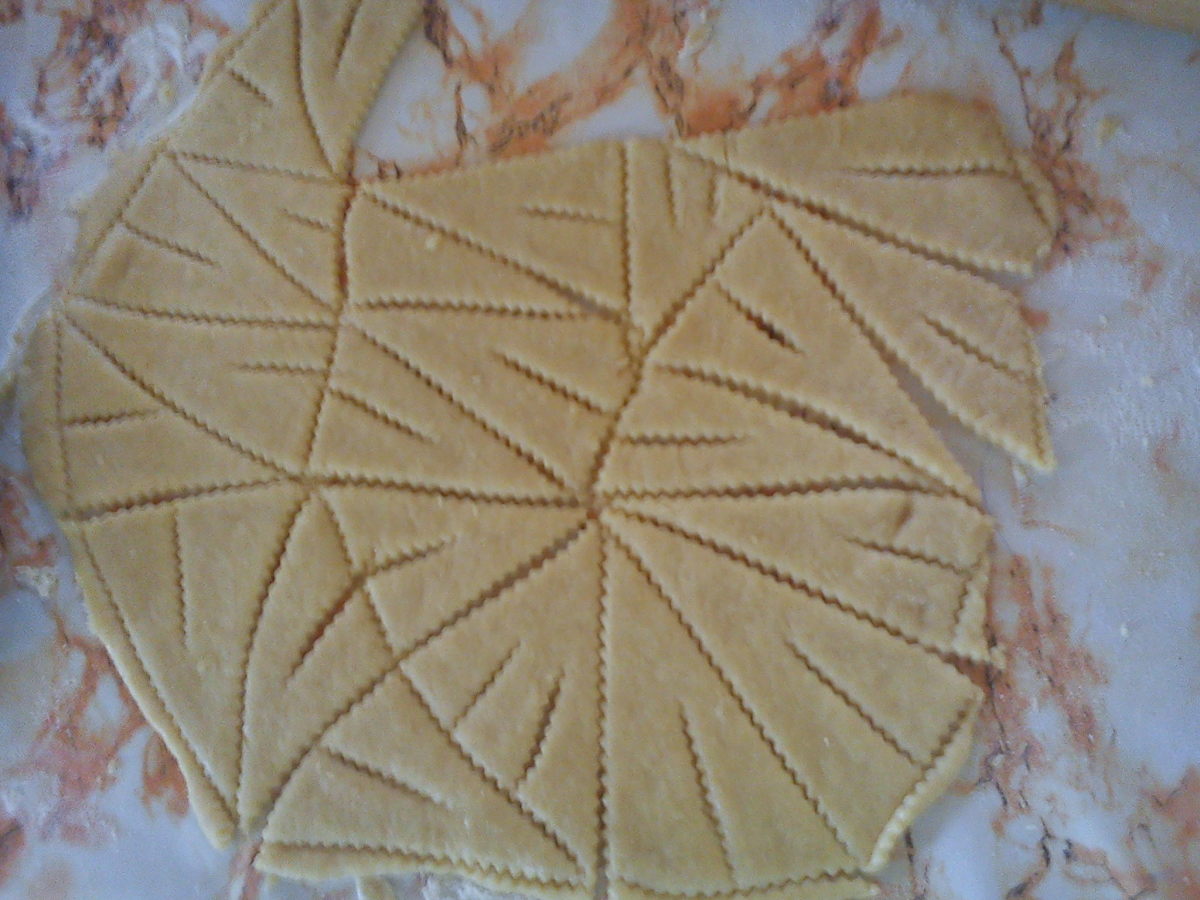CROATIAN CVITE – a Croatian cookie recipe
The story behind the recipe.
I first tried these cookies at the Croatian club in San Pedro, where my dad occasionally brought us to keep up with friends and family from the “Old Country”. They were good, light and airy, citrus combined with anise and practically dissolved into my mouth. Granted, they were different in Croatia than in America due to slightly different ingredients, I made it a priority to learn how to “make them right!” like my grandma Antonia probably did.
When I first came to Vis in 1999, I asked my neighbor, Lukrija Gospodinović, a retired chef from the hotel Tamaris to please show me how. Another neighbor, Teta Mandina Roki, showed me how the milk grows up over the metal pot and into the mixed dough below. I am forever grateful to these kind ladies, and I’m really glad I learned, since neither one is with us anymore. In the olden days, people made these cookies for weddings, using farm fresh eggs- instead of the wedding cake we usually see nowadays.
These cookies also helped me break free from a housewife existence. Right after my second child was born, I began baking and selling them to the Restaurant at Breakfast with Tihana located on the Riva in Vis. These cookies were kind of a launching pad for me before going back to work again. becoming a successful tour guide and then finally becoming self-employed.
So – with no further ado – may I present – “CROATIAN CVITA”.
Sweet and Low
Any special occasion wouldn’t be complete without these dry, break in your mouth cookies with an unusual combination of citrus and anise. The bubbly, airy texture of the cookie is due to the tablespoon of ammonia bicarbonate, which can be bought at the pharmacy. It’s dissolved in hot milk to make a “science project” eruption of foam which is added to the cookie dough. The ammonia lends an unusual but delightful taste and texture which lends to the cookie’s dry, bubbly texture (like well risen bread).
It’s called Cvite (svee-tuh), which means Flowers, and is cut to resemble a stem with leaves and flowers. I prefer using a pizza dough cookie cutter to give them a zig-zag edge, but using a knife is perfectly acceptable. Practically speaking, they end up looking like a “V” (peace symbol made with two fingers) or a “Y”-shape.
How to’s for the ultimate baked cookie recipe
The recipe
Whip up four egg whites, preferably from farm fresh eggs. When they are stiff, cover them and put them in the refrigerator.
In a medium sized bowl, whip together the following, step by step:
First, cream together the shortening and the sugar.
1 cup of white sugar
1 cup of shortening – preferably bacon grease or lard – it gives a slightly salty taste
Second, add the egg yolks, one at a time to ensure good blending.
4 egg yolks (home grown is well worth the trouble – find a farmer!)
And now for the flavorings:
Rind of one lemon
Rind of one orange
1 T. vanilla
1 T. Rum
1/2 T. anise flavoring
Mix well.
Dry Ingredients:
In a separate, larger bowl, mix together 1 tsp salt into a pound of regular self rising flour and a pound of cake flour. Mix well with a fork or a pastry blender, until it has a nice fine consistency.
Make a well in the center – in other words, dig a big hole in the center of your bowl. In the big hole, and add the wet mixture (egg yolks, vanilla, etc).
Now for the Science Part
Here comes the fun part:
On the stove heat up a little bit of milk – no more than 1/2 a cup. When it starts to rise, add a heaping tablespoon of already prepared amonia powder. If it has lumps, it needs to be crushed so it will dissolve easily into the milk.
Holding the pot with a potholder of course, with the batter underneath, mix the spoonful of ammonia into the milk, and the whole pot will overflow with foam! No problem, let it fall right into the batter. A never ending stream of foam will erupt into the batter, which needs to be mixed well at the end.
Now retrieve the already beaten egg whites from the fridge and mix a little bit more.
When the batter is nice and mixed, let it sit for a half hour – cover with a fresh clean towel or dishrag and leave it out at room temperature. It is still in shock!
You may need to add a little more flour to absorb the moisture from the milk and egg whites. The blob of dough should be moist and supple, a little like a generous blob of clay to work with (a bit later!).
Croatian cookies – roll and cut like a puzzle

Arrange the Cookies in a nice Formation

Roll Baby Roll
Rolling out the dough
First – a note about the dough consistency.
It should be sweet, but not sticky. If it sticks to your fingers, add more flour (a little more – easier to add than to take away!) The dough should also be moist. Too much flour creates dryness.
The end result of the cookie should be about as thick as your little finger, as long as you are not Shrek. Keeping this in mind, while rolling out the dough, your aim is to create the same thickness across the table. Subtle or not so subtle differences in thickness results in burned cookies, since some will be done much earlier. Keep the thickness around 1 miimeters, patting down with your hands (a love pat) to give the cookies a good start.
I usually roll them out on the kitchen table, by making a big circle and cutting outwards. Then I trim the outside edges of my “ink blot” with the pizza cutter. From the center outwards, I start making inverted and upright triangles, which will become cvite.
Bake me a Cvita
On a moderately oiled cookie sheet, put as many cvite as you can (inverting the triangle shapes, of course) since they don’t spread out at all.
The bake in about 10 minutes (you will smell them – mmm) at 375 F. or 210 degrees C. Normal baking temperature for sweets like cake, etc., is 325 to 350 or 180 to 200. This cookie goes up a notch – it cooks quickly at a slightly higher temperature.
One batch makes around four cookie sheets filled with cvite. Once they have cooled down a bit, they are ready to be topped with the sugar topping.
Top This!
Just a note about the sugar in the recipe.
If you know someone who has to seriously limit their sugar, the cup of sugar for the fifty – plus cookies you will get is not excessive. If you are a diabetic, simply omit about half the sugar and they are probably considered acceptable to eat. Check with your doctor. I know my father ate them “bare” without topping, and didn’t suffer any consequences.
Now for the topping, which I simply can’t imagine omitting!
Sugar topping
Once the cvite are cooled – at least an hour later – you will do the sugar topping.
In a ceramic coffee cup, mix 1 T Rum, 1 tsp Anise flavoring and any other sweet liquor. Paint onto the cookies with a cooking paintbrush – lightly is fine – then turn them upside down in a plate of 50/50 sugar or sprinkle the sugar on top. 50/50 refers to half granulated, half powdered sugar.
If you don’t have a brush, the back of a tablespoon is also a possibility, as is a fork (dip, then pass the back of the spoon or fork across the top of the cvita).
Storage
These cookies can be stored for a couple of weeks (perhaps more) in a sealed container. Good for having on hand for unexpected company. That is – if they don’t get eaten before hand!

We make these here too in Australia, my family isn’t far from Vis, they are from Blato, Korcula.
Hi Jodi! Actually there is another connection, maybe you know that people from Vis founded the settlement of Lombardo on Korčula? There are many great cookies from the islands… Cvite, Hrustule, and Medenjaci (honey-pepper spice cookies) are a few. Thanks for your comment and see you around!
Dear Marilyn, thanks for your comment. I always learned more from the baker by watching him or her do it – that’s why I get descriptive. Often it’s these little things that can make a difference in whether a recipe turns out well or gets tossed into the trash can. If you like, download my free recipe book for new subscribers. I will get some more recipes on the blog eventually. Warm greetings to the Croatians in a land down under!
Does it really take 2 pounds of flour? I am in the midst of making these but the dough is dry and crumbly. I think I have about twice as much flour as needed,
Hi Holly! Yes, one kilo of flour – which is equal to 2.2 lbs of flour. If you measured correctly, it should be OK! What you might do is try using half the flour, make a well, add the wet ingredients inside the well, then moistly and homogenously mix it all together, adding a little more flour until you get the right consistency. It could be a variance due to the size of your eggs, not all eggs are the same size. Another tip: be sure to measure all the other ingredients. If you are eyeballing amounts, that could make a difference. The main thing is that it turns out ok, so be conservative and start with half a kilo and add flour until the batter is easy to work with but doesn’t stick to your fingers (this is a clue that it is still too moist). I hope that works out well for you. Dalmatian Expression (which I have heard numerous times) by the old ladies on the islands: “Even cats throw out their first litter” which translates in the world of cooking “don’t be surprised if you aren’t thrilled with the first batch, try again!” Good luck.